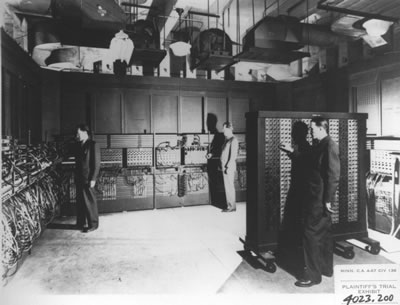

|
ENIAC

 The
fundamental mechanism of the ENIAC was the vacuum tube,
which until that time had been used primarily in loud speakers (the vacuum
tube had enabled the "talking movie") and radios. Each
of the ENIAC's vacuum tubes was about the size of one of today's household
light bulbs.
The
fundamental mechanism of the ENIAC was the vacuum tube,
which until that time had been used primarily in loud speakers (the vacuum
tube had enabled the "talking movie") and radios. Each
of the ENIAC's vacuum tubes was about the size of one of today's household
light bulbs.
Here, however, the vacuum tube was used not as an amplifier but rather as a switch in an electrical circuit—that is, as a device that could switch between two states: on and off.
Moreover, the vacuum tube is an electronic switch. Unlike a light switch, which, although electrical, is still mechanical because it requires physical movement to turn on and off, a vacuum tube can switch between its on and off states without physically moving (only electrons are moving!). Thus, an electronic switch can alternate its on and off states thousands of times faster than any mechanical switch.
This is an important general principle in computing: things that are electronic—i.e., that involve no moving parts—are always much faster than things that are mechanical—i.e., that involve physical movement. (This why electronic memory chips are so much faster than hard drives, which must spin and have moving read/write heads.)
ENIAC contained over 17,000 vacuum tubes at a time when the greatest number of vacuum tubes that had ever appeared together in an appliance was a couple dozen. No wonder so many skeptics thought the ENIAC would never run—or, even if it did, would use so much power, generate so much heat, and require so many replacements of burned-out vacuum tubes that it was only a matter of time before it was out of service again. However, ENIAC worked. (Rumor has it that the lights of Philadelphia dimmed whenever ENIAC ran.)
ENIAC filled an entire room. Imagine: the ENIAC machine was programmed by standing inside the CPU, rewiring the connections between functional units in the machine—a very long and tedious process. (Here, too, women did much of the programming.)
And yet the ENIAC contained less computing power than the throw-away chips one finds inside greeting cards that play music.
After Presper Eckert and John Mauchly had already developed and built much of the ENIAC, John von Neumann, a mathematician, joined the team. Although it is evident that Eckert and Mauchly first thought of the idea of actually storing the program in the computer's memory (rather than forming the program by rewiring), the concept of storing both data and program code in the memory of the computer has been labeled a von Neumann machine. Thus Charles Babbage's dream of a separation of hardware and software was realized.
Note: Technically, ENIAC was not the first electronic computer. That honor goes to John Atanasoff and Clifford Berry's Atanasoff-Berry Computer (ABC), developed at Iowa State University shortly before the ENIAC.
Photo provided courtesy of the Charles Babbage Institute, University of Minnesota.
![]()
![]()
These pages were written by Steven H. VanderLeest and Jeffrey Nyhoff and edited by Nancy Zylstra
©2005 Calvin University (formerly Calvin College), All Rights Reserved
If you encounter technical errors, contact computing@calvin.edu.